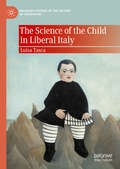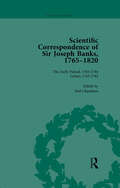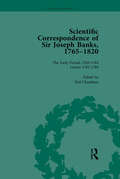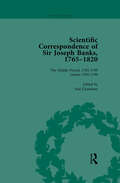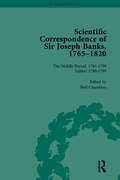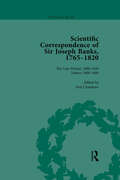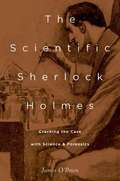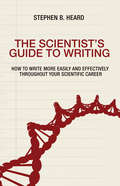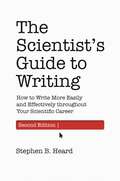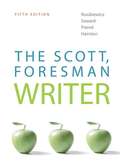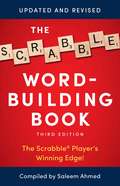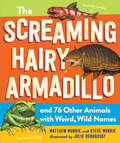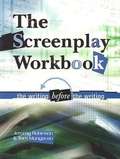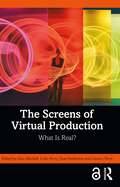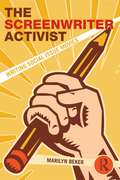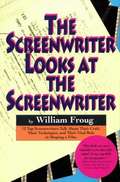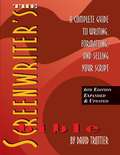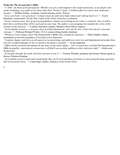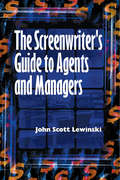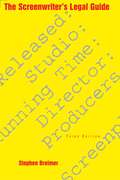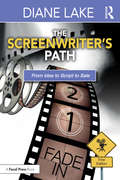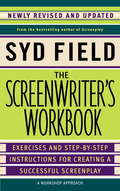- Table View
- List View
The Science of the Child in Liberal Italy (Palgrave Studies in the History of Childhood)
by Luisa TascaThis book investigates a forgotten chapter of history: the role of Italian sciences within the child study movement. Between the 1880s and the First World War, children became the focus of unprecedented professional and scientific interest in Europe and the United States. The bodies and psyches of children, their care and growth, their development, 'normal' and 'abnormal', intelligence, and moral sense, constituted a new field of research. Italy, which had just become a nation, also took part in this international movement: on the study of the child, a substantial part of the Italian ruling class launched itself, with a mixture of enthusiasm, hope and concern, on the frontier between different areas of knowledge. Using a broad spectrum of sources, this book offers the first overview of the Italian scientific movement of child study.
The Scientific Correspondence of Sir Joseph Banks, 1765-1820 Vol 1
by Neil ChambersA record of fifty years of intellectual and technological activity. This record provides an insight into the development of science and discovery from the Eighteenth to the early Nineteenth Century. It links British science and society to developments on the continent of Europe, the West Indies, North America and to countries farther afield.
The Scientific Correspondence of Sir Joseph Banks, 1765-1820 Vol 2
by Neil ChambersA record of fifty years of intellectual and technological activity. This record provides an insight into the development of science and discovery from the Eighteenth to the early Nineteenth Century. It links British science and society to developments on the continent of Europe, the West Indies, North America and to countries farther afield.
The Scientific Correspondence of Sir Joseph Banks, 1765-1820 Vol 3
by Neil ChambersA record of fifty years of intellectual and technological activity. This record provides an insight into the development of science and discovery from the Eighteenth to the early Nineteenth Century. It links British science and society to developments on the continent of Europe, the West Indies, North America and to countries farther afield.
The Scientific Correspondence of Sir Joseph Banks, 1765-1820 Vol 4
by Neil ChambersA record of fifty years of intellectual and technological activity. This record provides an insight into the development of science and discovery from the Eighteenth to the early Nineteenth Century. It links British science and society to developments on the continent of Europe, the West Indies, North America and to countries farther afield.
The Scientific Correspondence of Sir Joseph Banks, 1765-1820 Vol 5
by Neil ChambersA record of fifty years of intellectual and technological activity. This record provides an insight into the development of science and discovery from the Eighteenth to the early Nineteenth Century. It links British science and society to developments on the continent of Europe, the West Indies, North America and to countries farther afield.
The Scientific Correspondence of Sir Joseph Banks, 1765-1820 Vol 6
by Neil ChambersA record of fifty years of intellectual and technological activity. This record provides an insight into the development of science and discovery from the Eighteenth to the early Nineteenth Century. It links British science and society to developments on the continent of Europe, the West Indies, North America and to countries farther afield.
The Scientific Sherlock Holmes: Cracking the Case With Science and Forensics
by James O'BrienOne of the most popular and widely known characters in all of fiction, Sherlock Holmes has an enduring appeal based largely on his uncanny ability to make the most remarkable deductions from the most mundane facts. The very first words that Sherlock Holmes ever says to Dr. Watson are, "How are you? You have been in Afghanistan, I perceive. " Watson responds, "How on earth did you know that?" And so a crime-solving legend is born. In The Scientific Sherlock Holmes, James O'Brien provides an in-depth look at Holmes's use of science in his investigations. Indeed, one reason for Holmes's appeal is his frequent use of the scientific method and the vast scientific knowledge which he drew upon to solve mysteries. For instance, in heart of the book, the author reveals that Holmes was a pioneer of forensic science, making use of fingerprinting well before Scotland Yard itself had adopted the method. One of the more appealing aspects of the book is how the author includes real-world background on topics such as handwriting analysis, describing how it was used to capture the New York Zodiac killer and to clinch the case against the Lindbergh baby kidnapper. Sherlock Holmes was knowledgeable about several sciences, most notably chemistry. Therefore the book takes a close look at Holmes the chemist and discusses, for example, chemical poisons such as carbon monoxide, chloroform, and Prussic acid (the historical name for hydrogen cyanide). The author also debunks Isaac Asimov's famous assertion that Holmes was a blundering chemist. In addition, the book discusses mathematics, physics, biology, astronomy, meteorology, and geology, always in the context of Holmes's exploits. Sherlock Holmes continues to fascinate millions of readers and movie goers alike. The Scientific Sherlock Holmes is a must-read for the legion of fans of this most beloved of all fictional detectives.
The Scientist's Guide to Writing: How to Write More Easily and Effectively throughout Your Scientific Career
by Stephen B. HeardThe ability to write clearly is critical to any scientific career. The Scientist's Guide to Writing provides practical advice to help scientists become more effective writers so that their ideas have the greatest possible impact.Drawing on his own experience as a scientist, graduate adviser, and editor, Stephen Heard emphasizes that the goal of all scientific writing should be absolute clarity; that good writing takes deliberate practice; and that what many scientists need are not long lists of prescriptive rules but rather direct engagement with their behaviors and attitudes when they write. He combines advice on such topics as how to generate and maintain writing momentum with practical tips on structuring a scientific paper, revising a first draft, handling citations, responding to peer reviews, managing coauthorships, and more.In an accessible, informal tone, The Scientist's Guide to Writing explains essential techniques that students, postdoctoral researchers, and early-career scientists need to write more clearly, efficiently, and easily.Emphasizes writing as a process, not just a productEncourages habits that improve motivation and productivityExplains the structure of the scientific paper and the function of each partProvides detailed guidance on submission, review, revision, and publicationAddresses issues related to coauthorship, English as a second language, and more
The Scientist’s Guide to Writing, 2nd Edition: How to Write More Easily and Effectively throughout Your Scientific Career
by Stephen B. HeardAn updated and expanded edition of the acclaimed writing guide for scientistsThe Scientist’s Guide to Writing explains the essential techniques that students, postdocs, and early-career scientists need to write more clearly, efficiently, and easily. Now fully updated and expanded, this incisive primer offers practical advice on such topics as generating and maintaining writing momentum, structuring a scientific paper, revising a first draft, handling citations, responding to peer reviews, managing coauthorships, and more. The ability to write clearly is critical to any scientific career. The Scientist’s Guide to Writing shows scientists how to become better writers so that their ideas have the greatest possible impact.New chapters discuss effective reading, choosing the right journal for your research, and the advantages and disadvantages of posting preprintsProvides additional advice on reporting statistical results, dealing with conflicting peer reviews, managing coauthorships, writing with English as an additional language, and moreEmphasizes writing as a process, not just a productEncourages habits that improve motivation and productivityOffers detailed guidance on submission, review, revision, and publicationIncludes a wealth of new exercises
The Scots: A Genetic Journey
by Alistair MoffatThis unique &“fusion of science and the physical history&” traces the story of the Scots through their DNA (Sunday Herald). An almost limitless archive of our history lies hidden inside our bodies, and this book traces the ancient story of Scotland from that scientific viewpoint. The mushrooming of genetic studies, of DNA analysis, is rewriting history in spectacular fashion. In Scotland: A Genetic Journey, Alistair Moffat explores the history that is printed on our genes, and in a remarkable new approach, uncovers the detail of where Scots are from, where they have journeyed, and who they are—and in so doing, vividly colors in a DNA map of Scotland. &“[Moffat] is wonderfully able to communicate the epic elements of the story.&” —Scotsman
The Scott, Foresman Writer (5th Edition)
by John Ruszkiewicz Daniel E. Seward Christy Friend et alKnown for its innovative coverage of argument, in its fifth edition the SF Writer continues to offer writers the most innovative support in documentation, visual rhetoric and applying writing beyond the composition classroom. This is the brief handbook that reflects where the field is going, and provides students with the solutions they will use to strengthen their writing in college and beyond.
The Scrabble Word-Building Book: Updated Edition
by Saleem AhmedWant to outsmart, outwit, and outplay your Scrabble® opponents? Using the completely revised and updated The Scrabble® Word-Building Book, you can! This essential strategy guide shows you how to build on your opponents' words and become a master of this classic game. For novice players and expert wordsmiths alike, this helpful reference includes: A handy list of the 94 two-letter words sure to pile on the points Over 800 three-letter words -- 550 of which can be formed from two-letter words All eight-letter words that can be formed from seven-letter words Every word up to seven letters you can play! To increase your word-building power and achieve the highest score, keep The Scrabble® Word-Building Book at your fingertips -- and beat your opponent every time!
The Screaming Hairy Armadillo and 76 Other Animals with Weird, Wild Names
by Matthew Murrie Steve MurrieA fascinating compendium featuring over 70 unusual animal species. What's in a name? This lively, illustrated celebration is jam-packed with creatures notable for their bizarre, baffling, and just-plain-funny names. Meet the White-Bellied Go-Away Bird, whose cry sounds like someone screaming, "Go away!" Or the Aye-Aye, whose name means "I don't know" in Malagasy because no one wants anything to do with this bad-luck creature. Some are obvious, if still weird––guess what the Fried Egg Jellyfish looks like. Others sound like an inside joke: It's easy to figure out what was on the taxonomist's mind when he christened a fly he discovered Pieza Pie. Along the way you'll learn all about these curiously named animals' just-as-curious habits, appearances, and abilities.
The Screenplay Workbook: The Writing Before the Writing
by Jeremy Robinson Tom MungovanThis perforated-page workbook for students learning to write screenplays includes numerous worksheets, charts, and fill-in lists designed to help students focus on essential aspects of the screenplay. Worksheets are provided for concept creation, character development and relationships, plot structure, plot points, character arc, and scenes. Online resources are listed and described. The authors are screenplay writers. Annotation (c)2003 Book News, Inc. , Portland, OR (booknews. com)
The Screens of Virtual Production: What is Real?
by Sean Redmond Lienors Torre Sian Mitchell Colin PerryThis book is the first dedicated edited collection that explores the virtualisation of screen-making processes from pre-production to post-production, while attuning to the aesthetic, ideological and performative contexts upended by these integrated technologies. This book explores what is real in virtual production, as a provocative one, implicitly drawing on the philosophies of the moving image and the recent work on new forms of post-human perceptual realism.This edited collection is divided into the following four themed sections. Section One, It’s Always Been Real: Contemporising Virtual Production, addresses the histories of film realism in relationship to visual technologies, providing both a theoretical and philosophical ‘anchor’ point for the collection, and a necessary genealogy. Section Two, The Body Becomes You: Performing Virtual Production, examines the transformation that occurs in immersive virtual worlds, while also exploring how the body is itself virtualised. Section Three, Skin Deep: Gazing with Virtual Production, addresses the way race, ethnicity, gender and environment are supposedly equalised, and yet are still found to reproduce the colonised looking regimes of western, mainstream screen culture. Section Four, Whose Work? Labouring with Virtual Production, draws together writing that examines the way production processes have been transformed, affecting not only work patterns but also the way aesthetics, form and function, operate.This book encompasses many production themes and will appeal to media students and professionals interested in the production of film.
The Screenwriter Activist: Writing Social Issue Movies
by Marilyn BekerHotel Rwanda. Philadelphia. Silkwood. Some of the most important films ever made have tackled real-world social issues, from genocide to homophobia to corporate greed. As storytellers, activist screenwriters recognize that social issues make great stories that can be gut-wrenching, heart-tugging, funny, tragic, and interesting to watch. The Screenwriter Activist helps screenwriters tell those stories in compelling, non-preachy, and inspiring ways. The Screenwriter Activist is an in-depth, practical guide, appropriate for students in intermediate or graduate screenwriting courses in Film and English Programs as well as professionals who want to write a movie that can make a difference in the world. Using examples from classic and recent popular films, The Screenwriter Activist: Explores the motivation and sensibility a screenwriter needs to embark on a social issue project Gives techniques for choosing compelling subjects Provides historical context for social issue movies Explains how characters legitimize social issue themes Puts forward specific models for structuring advocacy screenplays Lays out a roadmap for how screenwriters can get a social issue movie made If you care deeply about social issues and recognize that films can be highly effective platforms for motivativng audiences to civic involvement and social action, this is the one screenwriting book you need to read.
The Screenwriter Looks at the Screenwriter
by William FrougTwelve of Hollywood's top screenwriters discuss their craft and their lives, including: Johnson 'Grapes of Wrath', Diamond 'Some Like It Hot', Henry 'The Graduate', and Lardner 'M*A*S*H'.
The Screenwriter Within: How to Turn the Movie in Your Head into a Salable Screenplay
by D. B. GillesIf you've ever dreamed of writing a screenplay,The Screenwriter Withinis the book for you. Insightful, inspirational, and wildly irreverent, it takes you through all the stages of the writing process, using references to hit movies and the author's personal experience to show you how to: Turn everyday events into big-screen successes Find the best stories to turn into screenplays Develop strong characters Write compelling dialogue Find your niche as a screenwriter . . . and much more.
The Screenwriter's Bible: A Complete Guide To Writing, Formatting, And Selling Your Script
by David TrottierThe Bible is five books bound into a single volume. -- a screenwriting primer (provides a concise presentation of screenwriting basics) -- a formatting guide (presents both correct screenplay and teleplay formats) -- a screenwriting workbook (the writing process, from nascent ideas to revisions) -- a sales and marketing guide (offers a marketing plan and sales strategies) -- a resource guide (provides contacts for industry organizations, guilds and unions, schools, publications, support groups and services, contests, etc.)
The Screenwriter's Bible: A Complete Guide to Writing, Formatting, and Selling Your Script
by David TrottierThe Screenwriter s Bible's 7th edition marks the 25th anniversary of one of the most popular, authoritative, and useful books on screenwriting. A standard by which other screenwriting books are measured, it has sold over 340,000 copies in its 25-year life. Always up-to-date and reliable, it contains everything that both the budding and working screenwriter need under one cover five books in one!
The Screenwriter's Guide to Agents and Managers
by John Scott LewinskiThe lessons to be learned from this helpful guide show aspiring screenwriters, television writers, and novelists how to catch an agent's eye and develop a successful scriptwriting career. Step-by-step instructions reveal how to get around the "Catch 22" of the trade-that you can't get an agent until you've sold a script. Interviews with prominent agents and managers disclose how the power brokers choose material, what kinds of writers command their attention, and what they expect from the writers they sign on. Tips on how to write a winning spec script, how to word an effective query letter, how to forge a sound relationship with reps, and other invaluable advice fill this insider's guide.
The Screenwriter's Legal Guide: Third Edition
by Stephen BreimerThis authoritative guide will help both fledgling and established writers to negotiate the best deal, protect their work, and get fair compensation for it. One of the most powerful entertainment lawyers in Hollywood provides easy-to-understand, expert advice on all the legal issues involved in the business of screenwriting. He gives an enlightening explanation of the screenwriter's position in the industry and then provides a thorough discussion of contracts, options, and working with agents and lawyers. This book shows screenwriters what to give up as a lost cause and what to hold out for.
The Screenwriter's Path: From Idea to Script to Sale
by Diane LakeThe Screenwriter’s Path takes a comprehensive approach to learning how to write a screenplay—allowing the writer to use it as both a reference and a guide in constructing a script. A tenured professor of screenwriting at Emerson College in Boston, author Diane Lake has 20 years' experience writing screenplays for major studios and was a co-writer of the Academy-award winning film Frida. The book sets out a unique approach to story structure and characterization that takes writers, step by step, to a completed screenplay, and it is full of practical advice on what to do with the finished script to get it seen by the right people. By demystifying the process of writing a screenplay, Lake empowers any writer to bring their vision to the screen.
The Screenwriter's Workbook (Revised Edition)
by Syd FieldAt last! The classic screenwriting workbook—now completely revised and updated—from the celebrated lecturer, teacher, and bestselling author, Syd Field: “the most sought-after screenwriting teacher in the world”* No one knows more about screenwriting than Syd Field—and now the ultimate Hollywood insider shares his secrets and expertise, completely updating his bestselling workbook for a new generation of screenwriters. Filled with new material—including fresh insights and anecdotes from the author and analyses of films from Pulp Fiction to Brokeback Mountain—The Screenwriter’s Workbook is your very own hands-on workshop, the book that allows you to participate in the processes that have made Syd Field’s workshops invaluable to beginners and working professionals alike. Follow this workbook through to the finish, and you’ll end up with a complete and salable script! Learn how to: • Define the idea on which your script will be built • Create the model—the paradigm—that professionals use • Bring your characters to life • Write dialogue like a pro • Structure your screenplay for success from the crucial first pages to the final act Here are systematic instructions, easy-to-follow exercises, a clear explanation of screenwriting basics, and expert advice at every turn—all the moment-to-moment, line-by-line help you need to transform your initial idea into a professional screenplay that’s earmarked for success. The Perfect Companion Volume to Syd Field’s Revised and Updated Edition of Screenplay: The Foundations of Screenwriting *Hollywood Reporter
